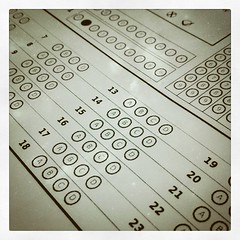 |
|
This is the antithesis of learning to be innovative
|
The new school year is starting, marked by more daily requests for Class Blogmeister accounts; professional development institutes; and the ubiquitous opening school event with the color guard led pledge of allegiance, acknowledgements from the chairman of the school board, and the out-of-town speaker.These years are different and not just for the throngs of teachers who are still looking for positions rather than schools struggling to fill classrooms with teachers. What’s different are education leaders who are mentioning with increased frequency phrases like 21st century skills and 21st century learning. Yet, I would find it interesting to challenge them to clearly and succinctly define and describe either phrase as a concept.
For certain, Innovation or its near cousin, creativity, would be a part of that explanation, even among those who stumble and stutter their ways through. ..and as professionals, we proceed to break down, classify, and sequence an approach to teaching innovation and creativity in a step by step fashion where by its achievement can be measured and accounted for. It makes me stop and wonder, “If you can teach and measure creativity, is it still creativity?” I don’t know.
I suspect that there are ways to help learners develop creativity as an assembly of resourceful problem-solving and goal accomplishing skills. Smarter people than me would know. I am certain, however, that innovation can be untaught. Acknowledging that some skills and knowledge should be assured, we should also accept that applying education and measuring it’s achievement requires a “right answer” and “wrong answer” approach. You’re either right or Wrong. It reminds me of the high school student who said, “The purpose of school is to not get caught being wrong.”
Learners are required to fill in the bubble of the right answer with a machine readable No.2 pencil — when, to help learners become innovative, we should ask, “How many different solutions can you think of for this problem — and defend?” Rather than how many students can come up with the same answer, we should celebrate the different answers that they can suggest — and defend.
My country is in a real mess, and it’s spread way beyond our own boarders. But I’m not pessimistic. You see, in the nearly sixty years that I have been around, the world has changed dramatically. Some of that change has happened too us. But much of it has been a result of really smart people (some of whom were not impressive students) thinking of brand new answers and brand new solutions and builting brand new technologies that have reshaped our cultures. Anyone my age has to be astounded by the innovation we have seen in just the last 30 years.
I’m not pessimistic because I think that we can innovate ourselves out of this mess, approaching it with something brand new, something that is not one old right answer — “Raise taxes,” “Cut spending,” “Regulate industry,” or “Hands off business.”
It will be something that is interesting, logical, brand new, and something we’ll all want to pat each other on the back for — and it will happen because we stopped teaching innovation out of our children.
 When I was young I played baseball and football (wasn’t fast enough for basketball and couldn’t jump with a flip). Soccer hadn’t arrived in small town America yet, and rugby was just another word for football, we thought — and we didn’t even know that football was just another word for soccer. But I digress.
When I was young I played baseball and football (wasn’t fast enough for basketball and couldn’t jump with a flip). Soccer hadn’t arrived in small town America yet, and rugby was just another word for football, we thought — and we didn’t even know that football was just another word for soccer. But I digress.





